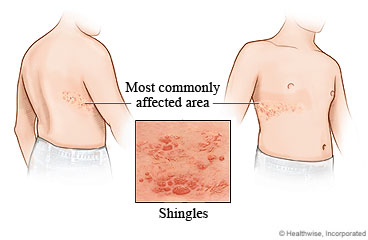
Overview
Shingles (herpes zoster) causes pain and a blistered rash. The rash can appear anywhere on the body but will be on only one side of the body, the left or right. It will be in a band, a strip, or a small area. The pain can be very severe. Shingles can also cause tingling or itching in the area of the rash. The blisters scab over after a few days and heal in 2 to 4 weeks. Medicines can help you feel better and may help prevent more serious problems caused by shingles.
Shingles is caused by the same virus that causes chickenpox. When you have chickenpox, the virus gets into your nerve roots and stays there (becomes dormant) long after you get over the chickenpox. If the virus becomes active again, it can cause shingles.
Follow-up care is a key part of your treatment and safety. Be sure to make and go to all appointments, and call your doctor if you are having problems. It's also a good idea to know your test results and keep a list of the medicines you take.
How can you care for yourself at home?
- Be safe with medicines. Take your medicines exactly as prescribed. Call your doctor if you think you are having a problem with your medicine. Antiviral medicine helps you get better faster.
- Try not to scratch or pick at the blisters.
- Keep the blisters moist until they heal over. One way to do this is to cover them with a thin layer of petroleum jelly, such as Vaseline, and a nonstick bandage.
- Take an over-the-counter pain medicine, such as acetaminophen (Tylenol), ibuprofen (Advil, Motrin), or naproxen (Aleve). Read and follow all instructions on the label.
- Avoid close contact with people until the blisters have healed. It is very important for you to avoid contact with anyone who has never had chickenpox or the chickenpox vaccine. Young babies and anyone who is pregnant or has a hard time fighting infection (such as someone with HIV, diabetes, or cancer) are especially at risk.
When should you call for help?
Call your doctor now or seek immediate medical care if:
- You have a new or higher fever.
- You have a severe headache and a stiff neck.
- You lose the ability to think clearly.
- The rash spreads to your forehead, nose, eyes, or eyelids.
- You have eye pain, or your vision gets worse.
- You have new pain in your face, or you can't move the muscles in your face.
- Blisters spread to new parts of your body.
- You have symptoms of infection, such as increased pain, swelling, warmth, or redness.
Watch closely for changes in your health, and be sure to contact your doctor if:
- The rash has not healed after 2 to 4 weeks.
- You still have pain after the rash has healed.
Where can you learn more?
Go to http://www.healthwise.net/patientEd
Enter X176 in the search box to learn more about "Shingles: Care Instructions".
Current as of: April 30, 2024
Author: Ignite Healthwise, LLC Staff
Clinical Review Board
All Healthwise education is reviewed by a team that includes physicians, nurses, advanced practitioners, registered dieticians, and other healthcare professionals.

